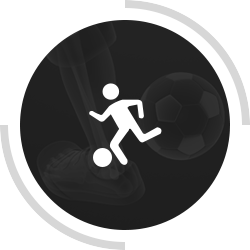Sports Medicine

What is a Sports Medicine?
Sports medicine is the medical specialty of improving athletic performance, recovering from injury and prevention of future injuries. Sports medicine professionals treat athletes, dancers, and those engaged in exercise of all ages and athletic ability, whether they are trying to reach peak athletic performance or regain full function after injury.
Prevention
There are several measures you can take to prevent sports-related injuries:
- Follow an exercise program to strengthen the muscles.
- Gradually increase your exercise level and avoid overdoing the exercise.
- Ensure that you wear properly-fitted protective gear such as elbow guards, eye gear, facemasks, mouth guards and pads, comfortable clothes, and athletic shoes before playing any sports activity, which will help reduce the chances of injury.
- Make sure that you follow warm-up and cool-down exercises before and after the sports activity. Exercises will help stretch muscles, increase flexibility and reduce soft tissue injuries.
- Avoid exercising immediately after eating a large meal.
- Maintain a healthy diet, which will nourish the muscles.
- Avoid playing when you are injured or tired. Take a break for some time after playing.
- Learn all the rules of the game you are participating in.
- Ensure that you are physically fit to play the sport.
Injuries
Sports injuries can occur during any form of workout and physical exertion. Injuries can range from mild aches and pains to severe, even requiring surgery.
- Overuse Children in the midst of their growth spurts can experience growing pains of the knee, foot or ankle (apophysitis), while the elderly can experience pains from degenerative joints and stiffer muscles, tendons, and ligaments. Professional athletes are subject to repetitive injuries, such as the shoulder and elbow of a baseball pitcher to the knee of an NBA basketball player. Injuries can range from bursitis and tendonitis to more severe stress fractures. Treatments are generally conservative but should be evaluated and treated by a multi-specialty team of your physician, therapists, and trainers.
- Trauma Athletes can sustain low or high-energy injuries that range from twists and sprains to fractures or dislocations. Depending on the severity, treatments can range from conservative to surgical management.
Common Injuries
Shoulder Injuries
Pain in your shoulders while playing your favorite sport such as basketball or tennis, or while exercising in the pool or gym, may be caused by an inflamed or even torn rotator cuff tendon. Overhead athletes are prone to SLAP tears of the biceps and labral attachment, while weightlifters can develop pain at their acromioclavicular (AC) joint or biceps tendonitis or even a tear. Shoulder dislocations, AC joint separations, labrum tears, and even fractures of the clavicle, glenoid or humerus bones can happen in collision sports such as football or lacrosse. Most injuries can be treated with conservative management while others may require surgical treatment. Making the correct diagnosis will lead to the appropriate treatment and speed recovery time.
Click here for more information on Shoulder Injuries
Elbow
Elbow pain in the athlete varies largely from one sport to the next. Pitchers can sprain or tear the ulnar collateral ligament at the elbow and require extensive rehabilitation or possibly even surgery to reconstruct the ligament (“Tommy John” surgery). Exercise training sessions can cause repetitive injuries like epicondylitis (tennis or golfers elbow) or bony impingement. Dislocations or fractures of the elbow can happen with falls onto an outstretched arm. A faster recuperation time is largely dictated by making the appropriate diagnosis and treatment plan.
Click here for more information on Elbow Injuries
Wrist/Hand
Both overuse and traumatic wrist and hand injuries are common. Contact sports such as football can lead to tackling injuries of the finger (Jersey finger) to collateral ligament sprains or fractures. Tendonitis and sprains are common in tennis and basketball. Simple pain or acute injuries may be treated with conservative treatment, while chronic injuries may require surgical treatment.
Click here for more information on wrist & hand injuries
Hip
The hip joint bears more weight and is more susceptible for injuries while playing sports. Hip injuries can range from repetitive over-use such as gluteus tendon and iliotibial band (ITB band) tendonitis, to fractures of the femur bone. Athletic pubalgia and sports hernias are often diagnosed in hockey and soccer players and must be properly diagnosed and treated. Labral tears of the hip may result from a traumatic dislocation in collision sports or from repetitive extremes of hip motion in ballet or martial arts. Some athletes who have congenital developmental dysplasia of the hip (shallow hip socket) or femoroacetabulum impingement (FAI) of the hip may have a higher chance of developing labrum tears and articular cartilage injuries. Long-distance athletes such as those participating in marathon and triathlon training, or those athletes who return to sport activity too fast from a period of inactivity, can develop stress fractures of the hip that require urgent treatment. Hip injuries require immediate medical intervention to avoid further complications. Rehabilitation programs and physical therapy is often recommended following medical intervention. In some cases, surgery may be required to return to the athlete to competition.
Click here for more information on Hip Injuries
Knee
The knee joint is highly susceptible to both repetitive and acute traumatic injuries. Iliotibial band (IT band) tendonitis and bursitis commonly afflicts the long distance runner, whereas basketball and volleyball players can develop patella or quacriceps tendonitis (Jumpers’ knee) from repetitive jumping activities. The anterior cruciate ligament (ACL) is major stabilizing ligament in the knee, which may tear with twisting injuries while playing sports. The ACL has poor ability to heal and may cause instability. Women have a significantly higher risk of tearing their ACL than men in sports like basketball and volleyball. Other common sports injuries in the knee include articular cartilage damage and meniscal tears. Although many injuries can be treated with conservative management, certain knee injuries during sports may require surgical intervention, which can be performed using open surgical or a minimally invasive technique. Most injuries may be treated with conservative management, however, some may require surgery to return the athlete to sports. Your doctor can best help guide you in choosing the appropriate treatment strategy.
Click here for more information on Knee Injuries
Ankle & Foot
The ankle joint is highly susceptible to both repetitive and acute traumatic injuries. Overuse injuries such as Achilles tendonitis and impingement are common in the ankle, whereas stress fractures, turf toe, and sesamoiditis can afflict the foot. Collision sports can result in fractures of the ankle and toe and even the tibia and fibula higher up. Most injuries can be treated with conservative management while others may require surgical treatment. Making the correct diagnosis will lead to the appropriate treatment and speed recovery time. Your doctor can best help guide you in choosing the appropriate treatment strategy.
Click here for more information on Ankle & Foot
Spine
Injuries of the cervical, thoracic and lumbar spine can happen with both repetitive and acute traumatic events. Making the correct diagnosis will lead to the appropriate treatment and speed recovery time. Your doctor can best help guide you in choosing the appropriate treatment strategy.
Click here for more information on Spine Injuries
School and College Pre-Screening for Athletic Participation
Pre-participation screening tests are extremely important for middle school, high school and college student athlete participation. Every year there are students who are picked up through athletic screenings events to have un-reported medical conditions, which could be dangerous for athletic participation, such as hypertrophic cardiomyopathy of the heart. Furthermore, pre-season concussion screening tests can help set a baseline for collision sport athletes to determine whether they have sustained an in-season traumatic brain concussion. Every year, Dr. Hommen performs pre-screening events at local high schools in Miami Dade.
Athletic Training and Physical Therapist Conferences
Dr. Hommen hosts regular conferences for Athletic Trainers and Physical Therapists. A thorough discussion of sports medicine topics of the shoulder, elbow, hip, knee, foot and ankle are discussed including: immediate emergency on-the-field treatment, diagnosis, therapeutic treatments and surgery.
Sports Medicine Links
Children
View a list of all Children articles
Interactive Learning Modules
General
- Compartment Syndrome
- Female Athlete Triad: Problems Caused by Extreme Exercise and Dieting
- Heat Injury and Heat Exhaustion
- High School Sports Injuries
- Muscle Contusion (Bruise)
- Muscle Cramp
- Overuse Injuries in Children
- Skin Infections in Athletes
- Sports Concussion
- Sprains, Strains and Other Soft-Tissue Injuries
Shoulder & Elbow
- Biceps Tendon Tear at the Elbow
- Biceps Tendon Tear at the Shoulder
- Burners and Stingers
- Chronic Shoulder Instability
- Common Shoulder Injuries
- Dislocated Shoulder
- Elbow Injuries in the Throwing Athlete
- Rotator Cuff Tears
- Shoulder Impingement/Rotator Cuff Tendinitis
- Shoulder Injuries in the Throwing Athlete
- Shoulder Joint Tear (Glenoid Labrum Tear)
- Shoulder Separation
- SLAP Tears
- Tennis Elbow (Lateral Epicondylitis)
- Throwing Injuries in the Elbow in Children
Hand & Wrist
Hip & Thigh
- Femoroacetabular Impingement
- Hamstring Muscle Injuries
- Hip Bursitis
- Hip Strains
- Muscle Strains in the Thigh
- Snapping Hip
- Sports Hernia (Athletic Pubalgia)
Knee & Lower Leg
- Adolescent Anterior Knee Pain
- Anterior Cruciate Ligament (ACL) Injuries
- Collateral Ligament Injuries
- Combined Knee Ligament Injuries
- Common Knee Injuries
- Compartment Syndrome
- Meniscus Tears
- Meniscus Tears (video)
- Osgood-Schlatter Disease (Knee Pain)
- Patellar Dislocation and Instability in Children (Unstable Kneecap)
- Patellar Tendon Tear
- Patellofemoral Pain Syndrome
- Pes Anserine (Knee Tendon) Bursitis
- Posterior Cruciate Ligament Injuries
- Prepatellar (Kneecap) Bursitis
- Quadriceps Tendon Tear
- Shin Splints
- Stress Fractures
- Unstable Kneecap
Foot & Ankle
- Achilles Tendon Rupture (Tear) (video)
- Ankle Fractures (Broken Ankle)
- Ankle Fractures in Children
- Lisfranc (Midfoot) Injury
- Sprained Ankle
- Stress Fractures of the Foot and Ankle
- Turf Toe
Neck & Back
Treatments & Surgeries
- ACL Injury: Does It Require Surgery?
- Alternative Methods to Help Manage Pain After Orthopaedic Surgery
- Arthroscopy
- Articular Cartilage Restoration
- Elbow Arthroscopy
- Foot and Ankle Conditioning Program
- Hip Arthroscopy
- Hip Conditioning Program
- Knee Arthroscopy
- Knee Conditioning Program
- Managing Pain With Medications After Orthopaedic Surgery
- Meniscal Transplant Surgery
- New Study Measures the Value of ACL Repair Surgery
- Orthotics
- Platelet-Rich Plasma (PRP)
- Rotator Cuff and Shoulder Conditioning Program
- Rotator Cuff Tears: Surgical Treatment Options
- Shoulder Arthroscopy
- Spine Conditioning Program
- X-rays, CT Scans and MRIs
Sports Injury Prevention
- Athletic Shoes
- Baseball Injury Prevention
- Basketball Injury Prevention
- Creatine Supplements
- Football Injury Prevention
- Golf Injury Prevention
- Gymnastics Injury Prevention
- Helmet Safety
- Hockey Injury Prevention
- Horseback Riding Injury Prevention
- Martial Arts Injury Prevention
- Return To Play
- Safe Exercise
- Skiing Injury Prevention
- Soccer Injury Prevention
- Sports Injury Prevention for Baby Boomers
- Sports Nutrition
- Swimming Injury Prevention
- Tennis Court Safety
- Tennis Injury Prevention
- The Risks of Steroid Use
- Tips for a Safe Running Program
- Train Smart and Stay Strong
- Trampoline Injury Prevention
- Volleyball Injury Prevention
- Winter Sports Injury Prevention
- Yoga Injury Prevention
Patient Stories
Patient Story: Knee Ligament Injuries
En Español
- Codo de tenista (epicondilitis lateral) (Tennis Elbow (Lateral Epicondylitis))
- Compresión del hombro/ Tendinitis del manguito rotador (Shoulder Impingement/Rotator Cuff Tendinitis)
- Desgarres del manguito de los rotadores (Rotator Cuff Tears)
- Desgarros de los meniscus (Meniscus Tears)
- Dolor de rodilla anterior en adolescentes (Adolescent Anterior Knee Pain)
- Esguinces, torceduras y otras lesiones de los tejidos blandos (Sprains, Strains and Other Soft-Tissue Injuries)
- Fractura del hueso escafoides de la muñeca (Scaphoid Fracture of the Wrist)
- Lesiones del ligamento cruzado anterior (Anterior Cruciate Ligament Injuries)
- Lesiones deportivas en la secundaria (High School Sports Injuries)
Em Português
- Lesões do ligamento cruzado anterior (LCA) (Anterior Cruciate Ligament (ACL) Injuries)
- Rupturas do menisco (Meniscus Tears)
General Orthopedic Links
Shoulder and Elbow
Broken Bones & Injuries
- Adult Forearm Fractures
- Biceps Tendon Tear at the Elbow
- Biceps Tendon Tear at the Shoulder
- Brachial Plexus Injuries
- Burners and Stingers
- Chronic Shoulder Instability
- Clavicle Fracture (Broken Collarbone)
- Common Shoulder Injuries
- Dislocated Shoulder
- Distal Humerus Fractures of the Elbow
- Elbow (Olecranon) Fractures
- Elbow Dislocation
- Elbow Fractures in Children
- Elbow Injuries in the Throwing Athlete
- Erb's Palsy (Brachial Plexus Birth Palsy)
- Forearm Fractures in Children
- Nursemaid's Elbow
- Radial Head Fractures of the Elbow
- Recurrent and Chronic Elbow Instability
- Rotator Cuff Tears
- Rotator Cuff Tears: Frequently Asked Questions
- Rotator Cuff Tears: Surgical Treatment Options
- Scapula (Shoulder Blade) Fractures
- Shoulder Impingement/Rotator Cuff Tendinitis
- Shoulder Injuries in the Throwing Athlete
- Shoulder Joint Tear (Glenoid Labrum Tear)
- Shoulder Separation
- Shoulder Trauma (Fractures and Dislocations)
- SLAP Tears
- Sternoclavicular (SC) Joint Disorders
- Throwing Injuries in the Elbow in Children
Diseases & Conditions
- Arthritis of the Shoulder
- Biceps Tendinitis
- Compartment Syndrome
- Elbow (Olecranon) Bursitis
- Erb's Palsy (Brachial Plexus Birth Palsy)
- Frozen Shoulder
- Osteoarthritis of the Elbow
- Recurrent and Chronic Elbow Instability
- Scapular (Shoulder Blade) Disorders
- Shoulder Impingement/Rotator Cuff Tendinitis
- Shoulder Pain and Common Shoulder Problems
- Sternoclavicular (SC) Joint Disorders
- Tennis Elbow (Lateral Epicondylitis)
- Thoracic Outlet Syndrome
- Ulnar Nerve Entrapment at the Elbow (Cubital Tunnel Syndrome)
Treatments & Surgeries
- Elbow Arthroscopy
- Rotator Cuff and Shoulder Conditioning Program
- Rotator Cuff Tears: Surgical Treatment Options
- Shoulder Arthroscopy
- Shoulder Joint Replacement
- Shoulder Surgery
- Shoulder Surgery Exercise Guide
- Thermal Capsular Shrinkage
- Total Elbow Replacement
Patient Stories
Patient Story: Rotator Cuff Tear
En Español
- Artritis del hombro (Arthritis of the Shoulder)
- Atrapamiento del nervio cubital en el codo (síndrome del túnel cubital) (Ulnar Nerve Entrapment at the Elbow (Cubital Tunnel Syndrome))
- Codo de tenista (epicondilitis lateral) (Tennis Elbow (Lateral Epicondylitis))
- Compresión del hombro/ Tendinitis del manguito rotador (Shoulder Impingement/Rotator Cuff Tendinitis)
- Dolor de hombro y problemas comunes del hombro (Shoulder Pain and Common Shoulder Problems)
- Ejercicio después de cirugía del hombro (Shoulder Surgery Exercises)
- Fracturas de los codos en los niños (Elbow Fractures in Children)
- Fracturas del antebrazo en los niños (Forearm Fractures in Children)
- Hombro congelado (Frozen Shoulder)
Wrist and Hand
Broken Bones & Injuries
- Animal Bites
- Distal Radius Fractures (Broken Wrist)
- Finger Fractures
- Fingertip Injuries and Amputations
- Flexor Tendon Injuries
- Hand Fractures
- Human Bites
- Lawn Mower Injuries in Children
- Mallet Finger (Baseball Finger)
- Nerve Injuries
- Scaphoid Fracture of the Wrist
- Sprained Thumb
- Thumb Fractures
- Wrist Sprains
Diseases & Conditions
- Arthritis of the Hand
- Arthritis of the Thumb
- Arthritis of the Wrist
- Boutonnière Deformity
- Carpal Tunnel Syndrome
- Compartment Syndrome
- Complex Regional Pain Syndrome (Reflex Sympathetic Dystrophy)
- Congenital Hand Differences
- De Quervain's Tendinosis
- Dupuytren's Contracture
- Ganglion Cyst of the Wrist and Hand
- Kienböck's Disease
- Rabies
- Trigger Finger
- Ulnar Tunnel Syndrome of the Wrist
Treatments & Surgeries
- Electrodiagnostic Testing
- Replantation
- Restoring Hand Function After Spinal Cord Injury
- What is a Hand Surgeon?
- Wrist Arthroscopy
- Wrist Joint Replacement (Wrist Arthroplasty)
En Español
- Dedo en gatillo (Trigger Finger)
- Fractura del hueso escafoides de la muñeca (Scaphoid Fracture of the Wrist)
- Fracturas distales del radio (muñeca quebrada) (Distal Radius Fractures (Broken Wrist))
- Quiste ganglionar de la muñeca y la mano (Ganglion Cyst of the Wrist and Hand)
- Síndrome de Dolor Regional Complejo (Distrofia Simpática Refleja) (Complex Regional Pain Syndrome)
- Acetabular Fractures
- Femur Shaft Fractures (Broken Thighbone)
- Fracture After Total Hip Replacement
- Hamstring Muscle Injuries
- Hip Dislocation
- Hip Fractures
- Hip Strains
- Muscle Strains in the Thigh
- Pelvic Fractures
- Thighbone (Femur) Fractures In Children
- Adolescent Hip Dysplasia
- Burning Thigh Pain (Meralgia paresthetica)
- Deep Vein Thrombosis
- Developmental Dislocation (Dysplasia) of the Hip (DDH)
- Femoroacetabular Impingement
- Hip Bursitis
- Inflammatory Arthritis of the Hip
- Osteoarthritis of the Hip
- Osteonecrosis of the Hip
- Perthes Disease
- Slipped Capital Femoral Epiphysis
- Snapping Hip
- Transient Osteoporosis of the Hip
- Activities After Hip Replacement
- Anesthesia for Hip and Knee Surgery
- Dislocation After Total Hip Replacement (video)
- Hip Arthroscopy
- Hip Conditioning Program
- Hip Resurfacing
- Minimally Invasive Total Hip Replacement
- Preventing Blood Clots After Orthopaedic Surgery (video)
- Questions and Answers About Metal-on-Metal Hip Implants
- Revision Total Hip Replacement
- Total Hip Replacement
- Total Hip Replacement Exercise Guide
- Actividades después de reemplazo de cadera (Activities After Hip Replacement)
- Bursitis de cadera (Hip Bursitis)
- Reemplazo total de cadera (Total Hip Replacement)
- Trombosis venosa profunda (Deep Vein Thrombosis)
- Anterior Cruciate Ligament (ACL) Injuries
- Collateral Ligament Injuries
- Combined Knee Ligament Injuries
- Common Knee Injuries
- Distal Femur (Thighbone) Fractures of the Knee
- Fractures of the Proximal Tibia (Shinbone)
- Growth Plate Fractures
- Meniscus Tears
- Meniscus Tears (video)
- Osgood-Schlatter Disease (Knee Pain)
- Patellar (Kneecap) Fractures
- Patellar Dislocation and Instability in Children (Unstable Kneecap)
- Patellar Tendon Tear
- Patellofemoral Pain Syndrome
- Posterior Cruciate Ligament Injuries
- Quadriceps Tendon Tear
- Shin Splints
- Stress Fractures
- Tibia (Shinbone) Shaft Fractures
- Unstable Kneecap
- Adolescent Anterior Knee Pain
- Arthritis of the Knee
- Bowed Legs (Blount's Disease)
- Burning Thigh Pain (Meralgia paresthetica)
- Compartment Syndrome
- Deep Vein Thrombosis
- Discoid Meniscus
- Limb Length Discrepancy
- Osgood-Schlatter Disease (Knee Pain)
- Osteonecrosis of the Knee
- Patellofemoral Arthritis
- Patellofemoral Pain Syndrome
- Pes Anserine (Knee Tendon) Bursitis
- Prepatellar (Kneecap) Bursitis
- ACL Injury: Does It Require Surgery?
- Activities After a Knee Replacement
- Anesthesia for Hip and Knee Surgery
- Care of Casts and Splints
- How to Use Crutches, Canes and Walkers
- Knee Arthroscopy
- Knee Arthroscopy Exercise Guide
- Knee Conditioning Program
- Knee Exercises
- Knee Replacement Implants
- Meniscal Transplant Surgery
- New Study Finds that Knee Replacement Is A Cost-Effective Treatment Option
- New Study Measures the Value of ACL Repair Surgery
- Osteotomy of the Knee
- Patellofemoral Replacement
- Preventing Blood Clots After Orthopaedic Surgery (video)
- Unicompartmental Knee Replacement
- Viscosupplementation Treatment for Knee Arthritis
- Patient Story: ACL and Meniscus Tears
- Patient Story: Infection After Fracture
- Patient Story: Knee Ligament Injuries
- Patient Story: Knee Ligament Injuries and Meniscus Tear
- Patient Story: Multiple Knee Injuries and Knee Instability
- Patient Story: Posttraumatic Arthritis and Total Knee Replacement
- Patient Story: Severe Fractures in the Leg
- Actividades posteriores a un remplazo de rodilla (Activities After Knee Replacement)
- Cuidado de yesos y férula (Care of Casts and Splints)
- Desgarros de los meniscus (Meniscus Tears)
- Ejercicio después de reemplazo de rodilla (Knee Replacement Exercises)
- Ejercicios después de artroscópica (Knee Arthroscopy Exercises)
- El síndrome de dolor patelofemoral (Patellofemoral Pain Syndrome)
- Lesiones del ligamento cruzado anterior (Anterior Cruciate Ligament Injuries)
- Piernas arqueadas (Bowed Legs)
- Trombosis venosa profunda (Deep Vein Thrombosis)
- Lesões do ligamento cruzado anterior (LCA) (Anterior Cruciate Ligament (ACL) Injuries)
- Rupturas do menisco (Meniscus Tears)
- Achilles Tendon Rupture (Tear) (video)
- Ankle Fractures (Broken Ankle)
- Ankle Fractures in Children
- Calcaneus (Heel Bone) Fractures
- Frostbite
- Lawn Mower Injuries in Children
- Lisfranc (Midfoot) Injury
- Pilon Fractures of the Ankle
- Sprained Ankle
- Stress Fractures of the Foot and Ankle
- Talus Fractures
- Toe and Forefoot Fractures
- Turf Toe
- Achilles Tendinitis
- Adult Acquired Flatfoot
- Arthritis of the Foot and Ankle
- Bunions
- Charcot-Marie-Tooth Disease
- Claw Toe
- Clubfoot
- Corns
- Diabetic (Charcot) Foot
- Flexible Flatfoot in Children
- Hammer Toe
- Heel Pain
- Ingrown Toenail
- Intoeing
- Morton's Neuroma
- Plantar Fasciitis and Bone Spurs
- Posterior Tibial Tendon Dysfunction
- Rheumatoid Arthritis of the Foot and Ankle
- Sesamoiditis
- Stiff Big Toe (Hallux Rigidus)
- Tarsal Coalition
- Vertical Talus
- Patient Story: Ankle Fracture
- Patient Story: Ankle Fracture and Chronic Ankle Laxity
- Patient Story: Ankle Joint Replacement
- Patient Story: Ankle, Elbow, and Vertebral Fractures
- Patient Story: Multiple Fractures in the Spine, Knees, and Ankles
- Patient Story: Severe Injuries and Fractures Lead to Multiple Surgeries
- Compresión del hombro/ Tendinitis del manguito rotador (Shoulder Impingement/Rotator Cuff Tendinitis)
- Cuidado del pie diabético (Care of the Diabetic Foot)
- El pie equino (Clubfoot)
- Fascitis plantar y protuberancias óseas (Plantar Fasciitis and Bone Spurs)
- Pie diabético (Charcot) (Diabetic Charcot Foot)
- Zapatos (Shoes)
- Back Pain in Children
- Cervical Fracture (Broken Neck)
- Fracture of the Thoracic and Lumbar Spine
- Herniated Disk
- Herniated Disk in the Lower Back
- Low Back Pain
- Neck Pain
- Neck Sprain
- Osteoporosis and Spinal Fractures
- Spondylolysis and Spondylolisthesis
- Adult Spondylolisthesis in the Low Back
- Back Pain in Children
- Cauda Equina Syndrome
- Cervical Radiculopathy (Pinched Nerve)
- Cervical Spondylosis (Arthritis of the Neck)
- Cervical Spondylotic Myelopathy (Spinal Cord Compression).
- Chordoma
- Congenital Muscular Torticollis (Twisted Neck)
- Congenital Scoliosis
- Idiopathic Scoliosis in Children and Adolescents
- Kyphosis (Roundback) of the Spine
- Low Back Pain
- Lumbar Spinal Stenosis
- Neck Pain
- Neuromuscular Scoliosis
- Sciatica
- Scoliosis: Frequently Asked Questions
- Spinal Deformity in Children with Myelomeningocele
- Spondylolysis and Spondylolisthesis
- Anterior Lumbar Interbody Fusion
- Artificial Disk Replacement in the Lumbar Spine
- Bone Grafts in Spine Surgery
- Cervical Radiculopathy: Surgical Treatment Options
- Cervical Spondylotic Myelopathy: Surgical Treatment Options
- Electrodiagnostic Testing
- Lateral Lumbar Interbody Fusion
- Low Back Surgery Exercise Guide
- Minimally Invasive Spine Surgery
- Posterior Lumbar Interbody Fusion and Transforaminal Lumbar Interbody Fusion
- Posterolateral Lumbar Fusion
- Preparing for Low Back Surgery
- Spinal Fusion
- Spinal Fusion Glossary
- Spinal Injections
- Spine Conditioning Program
- Treatment Options for Low Back Pain (video)
- A Patient's Experience with Incomplete Spinal Cord Injury
- Patient Story: Adolescent Idiopathic Scoliosis
- Patient Story: Ankle, Elbow, and Vertebral Fractures
- Patient Story: Chiari Malformation and Scoliosis
- Patient Story: Multiple Fractures in the Spine, Knees, and Ankles
- Patient Story: Scoliosis Treatment With Growing Rods
- Patient Story: Scoliosis Treatment With Spinal Fusion Surgery
- Cómo prevenir el dolor de espalda en el trabajo y el hogar (Preventing Back Pain at Work and at Home)
- Escoliosis idiopática en niños y adolescentes (Idiopathic Scoliosis in Children and Adolescents)
- Espondilosis cervical (osteoartritis de cuello) (Cervical Spondylosis)
- Estenosis de la columna lumbar (Lumbar Spinal Stenosis)
- Guía de ejercicios para la parte baja de la espalda (Back Exercises)
- Hernia de disco en la columna lumbar (Herniated Disk in the Lower Back)
- Lumbalgia (Low Back Pain)
- Radiculopatía cervical (nervio pinzado) (Cervical Radiculopathy (Pinched Nerve))
- Radiculopatía cervical: opciones de tratamiento quirúrgico (Cervical Radiculopathy: Surgical Treatment Options)
Em Português
Fraturas distais do rádio (fratura do punho) (Distal Radius Fractures (Broken Wrist))
Hip
Broken Bones & Injuries
Diseases & Conditions
Treatments & Surgeries
Health & Safety
Patient Stories
Resources
En Español
Em Português
Knee
Broken Bones & Injuries
Diseases & Conditions
Treatments & Surgeries
Patient Stories
Resources
En Español
Em Português
Ankle and Foot
Broken Bones & Injuries
Diseases & Conditions
Treatments & Surgeries
Health & Safety
Patient Stories
Resources
En Español
Spine
Broken Bones & Injuries
Diseases & Conditions
Treatments & Surgeries
Health & Safety
Patient Stories
Resources
En Español













